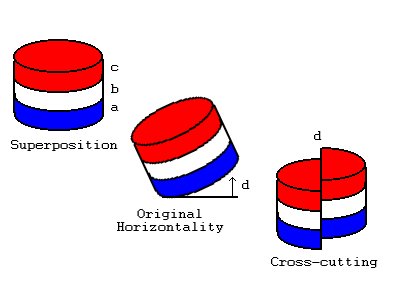
Module 6 Objectives: The objective of this module is to become familiar with how the history of earth is pieced together by paleontologists and geologists using relative or absolute dating techniques.
How do we know the earth is about 5 billion years old?
How do we know that the first mammals evolved on earth over 200 million years ago?
How do we know that dinosaurs became extinct and mammals began to diversify rapidly 65 million years ago?
How do we know that human agriculture is a technology developed in the last 10,000 years?
Background: How would you determine which part of a layered cake was older than another part? Geologists in the late 1700's in England, including William Smith (1769-1839) were addressing this question for rock layers. Their purpose was to better understand the layers they were mining (e.g., to find coal).
Relative Dating: Their work yielded several principles that are fundamental to understanding and establishing the relative ages of geologic features and fossils. Consider the figure below.

The Principle of Superposition holds that rock layers are deposited in a sequence (a-c) with the oldest being on the bottom. Related to superposition, the Principle of Faunal Succession holds that in a sequence of rocks, the oldest fossils will be in the oldest layers.
During mountain building or other tectonic disturbances rock layers can be tilted and faulted. They can also be or injected with or baked by igneous rocks from below. The Principle of Original Horizontality holds that when rocks layers are tilted, some tectonic event (d) happened after the layers were deposited. Likewise, the Principle of Cross-Cutting holds that if rocks have been cut (e.g., faulted), the cutting (d) is a later event.
By applying these principles to rocks and fossils, a geologic timescale and history is pieced together. Note that early on the absolute ages of rocks and fossils were not known, just the relative ages.
Absolute Dating:
An outcome of the study of radioactivity by Becquerel and the Curies in the early 1900's was the realization that certain atoms decayed in a systematic way through time. If atoms decayed in a predictable way, this information could be used to get absolute dates for rocks.
The way it is done is to study the amount of a parent isotope (element) and the product of decay, the daughter element.The relative amount of each indicates how much time has occurred since the formation of the rock. The stable daughter element will increase in abundance through time at the expense of the unstable parent isotope. Note: Isotopes = variant types of atoms, with a different number of neutrons.
Decay of Unstable Isotopes (RADIOACTIVITY)
Example:
238U (Uranium) is unstable and decays shedding part of its mass by expulsion of an "alpha particle" (Helium). The process changes the Uranium atom into a Thorium atom. The Thorium itself is not stable and decays. Ultimately, the original Uranium decays to become the atom Lead, which is very stable.
When half of the parent radioactive element has been transformed into daughter elements, we call say that a Half-life has occurred. For 238U the half-life is 4.4 billion years! By comparison, for carbon 14, the half life is around 5000 years.
There are many common radioactive elements used for dating the earth's materials. Another common pair used is potassium-argon.
In order to date the age of different rocks they must contain these elements in sufficient quantities to be measured by instruments (e.g., mass spectrometer). This is why typically fossils cannot themselves be dated, but rather the rocks enclosing them. The exception is using Carbon 14 for very young fossils ( less than 40,000 years old). Beyond this age, there is not enough Carbon 14 left to get a date.